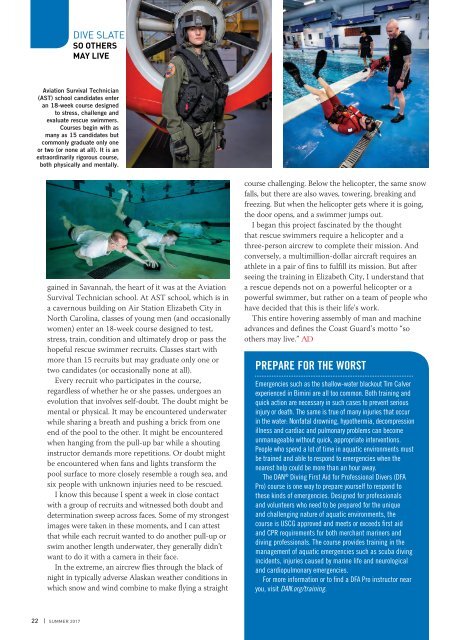AD 2017 Q3
Alert Diver is the dive industry’s leading publication. Featuring DAN’s core content of dive safety, research, education and medical information, each issue is a must-read reference, archived and shared by passionate scuba enthusiasts. In addition, Alert Diver showcases fascinating dive destinations and marine environmental topics through images from the world’s greatest underwater photographers and stories from the most experienced and eloquent dive journalists in the business.
Alert Diver is the dive industry’s leading publication. Featuring DAN’s core content of dive safety, research, education and medical information, each issue is a must-read reference, archived and shared by passionate scuba enthusiasts. In addition, Alert Diver showcases fascinating dive destinations and marine environmental topics through images from the world’s greatest underwater photographers and stories from the most experienced and eloquent dive journalists in the business.
You also want an ePaper? Increase the reach of your titles
YUMPU automatically turns print PDFs into web optimized ePapers that Google loves.
DIVE SLATE<br />
SO OTHERS<br />
MAY LIVE<br />
Aviation Survival Technician<br />
(AST) school candidates enter<br />
an 18-week course designed<br />
to stress, challenge and<br />
evaluate rescue swimmers.<br />
Courses begin with as<br />
many as 15 candidates but<br />
commonly graduate only one<br />
or two (or none at all). It is an<br />
extraordinarily rigorous course,<br />
both physically and mentally.<br />
gained in Savannah, the heart of it was at the Aviation<br />
Survival Technician school. At AST school, which is in<br />
a cavernous building on Air Station Elizabeth City in<br />
North Carolina, classes of young men (and occasionally<br />
women) enter an 18-week course designed to test,<br />
stress, train, condition and ultimately drop or pass the<br />
hopeful rescue swimmer recruits. Classes start with<br />
more than 15 recruits but may graduate only one or<br />
two candidates (or occasionally none at all).<br />
Every recruit who participates in the course,<br />
regardless of whether he or she passes, undergoes an<br />
evolution that involves self-doubt. The doubt might be<br />
mental or physical. It may be encountered underwater<br />
while sharing a breath and pushing a brick from one<br />
end of the pool to the other. It might be encountered<br />
when hanging from the pull-up bar while a shouting<br />
instructor demands more repetitions. Or doubt might<br />
be encountered when fans and lights transform the<br />
pool surface to more closely resemble a rough sea, and<br />
six people with unknown injuries need to be rescued.<br />
I know this because I spent a week in close contact<br />
with a group of recruits and witnessed both doubt and<br />
determination sweep across faces. Some of my strongest<br />
images were taken in these moments, and I can attest<br />
that while each recruit wanted to do another pull-up or<br />
swim another length underwater, they generally didn’t<br />
want to do it with a camera in their face.<br />
In the extreme, an aircrew flies through the black of<br />
night in typically adverse Alaskan weather conditions in<br />
which snow and wind combine to make flying a straight<br />
course challenging. Below the helicopter, the same snow<br />
falls, but there are also waves, towering, breaking and<br />
freezing. But when the helicopter gets where it is going,<br />
the door opens, and a swimmer jumps out.<br />
I began this project fascinated by the thought<br />
that rescue swimmers require a helicopter and a<br />
three-person aircrew to complete their mission. And<br />
conversely, a multimillion-dollar aircraft requires an<br />
athlete in a pair of fins to fulfill its mission. But after<br />
seeing the training in Elizabeth City, I understand that<br />
a rescue depends not on a powerful helicopter or a<br />
powerful swimmer, but rather on a team of people who<br />
have decided that this is their life’s work.<br />
This entire hovering assembly of man and machine<br />
advances and defines the Coast Guard’s motto “so<br />
others may live.” <strong>AD</strong><br />
PREPARE FOR THE WORST<br />
Emergencies such as the shallow-water blackout Tim Calver<br />
experienced in Bimini are all too common. Both training and<br />
quick action are necessary in such cases to prevent serious<br />
injury or death. The same is true of many injuries that occur<br />
in the water: Nonfatal drowning, hypothermia, decompression<br />
illness and cardiac and pulmonary problems can become<br />
unmanageable without quick, appropriate interventions.<br />
People who spend a lot of time in aquatic environments must<br />
be trained and able to respond to emergencies when the<br />
nearest help could be more than an hour away.<br />
The DAN ® Diving First Aid for Professional Divers (DFA<br />
Pro) course is one way to prepare yourself to respond to<br />
these kinds of emergencies. Designed for professionals<br />
and volunteers who need to be prepared for the unique<br />
and challenging nature of aquatic environments, the<br />
course is USCG approved and meets or exceeds first aid<br />
and CPR requirements for both merchant mariners and<br />
diving professionals. The course provides training in the<br />
management of aquatic emergencies such as scuba diving<br />
incidents, injuries caused by marine life and neurological<br />
and cardiopulmonary emergencies.<br />
For more information or to find a DFA Pro instructor near<br />
you, visit DAN.org/training.<br />
22 | SUMMER <strong>2017</strong>









